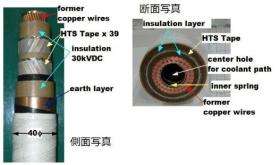March 8, 2010 report
World first superconducting DC power transmission system a step closer

(PhysOrg.com) -- A group of researchers in Japan have succeeded for the first time in superconducting power transmission of direct current over two hundred meters.
The researchers, from Nano-Optonics Energy Inc., and Chubu University’s Superconductivity and Sustainable Energy Center conducted their experiment as part of Nano-Optics Energy’s Superconducting DC Power Transmission Project.
The transmission loss of superconducting DC (alternating current) power transmission is ten times less than that of superconducting AC power transmission, and thirty times less than the transmission loss of ordinary AC power transmission. Since superconducting DC power reduces transmission loss, it could significantly reduce the amount of electricity that needs to be generated, if it could be used to replace normal AC power.
With the current emphasis on lower carbon emissions, the idea is attracting a great deal of attention, not only because less electricity would be needed, but also because alternative electricity generation methods such as solar and wind power generate direct current, which in the present system has then to be converted to alternating current. Using direct current would also reduce the losses that occur during the conversion process.
The system being developed uses a liquid nitrogen circulation system, an adiabatic double tube, and a newly developed type of superconducting cable. Other new technologies developed by the researchers for the new system include a new method of thermally insulating the ends of the cable. This method, called the Peltier Current Lead (PCL), drastically cuts heat transfer between the liquid nitrogen cooling system and the ambient temperature section.
Direct current power transmission also has the advantage over AC of being cheaper and more efficient when transmitted over distances of 300 km and above. Superconducting power transmission theoretically has zero energy loss, and larger current power transmission is possible and over much longer distances, with transmission over distances as great as 10,000 km being feasible.
Nano-Optonics Energy collaborates with Chubu University on a number of basic technology projects and research into developing more efficient batteries. Their aim is to develop the most efficient and largest current transmission system in the world, using high-temperature DC superconductors.
More information: Nano-Optonics Energy -- www.nano-opt.jp/en/superconductor.html
© 2010 PhysOrg.com

















